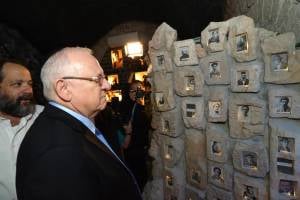
If we don’t believe in the promise, are we really any different than anyone else?
Last week I guided a family from Miami through Hebron. I have to admit that I was impressed when a week before their arrival in Israel, they called me to arrange a visit for them to that holy city. They told me that no visit to Israel would be complete without going to Hebron. I couldn’t agree more and here is why.
When God first communicates with Abraham (he is actually Abram at this point) in the Bible, He tells Abraham to leave his birthplace and to travel to the land that God will show him. So Abraham, obedient to God’s word, does so. As Abraham arrives at a place called Elon Moreh, God communicates with him again. This time he is told that the land of Canaan will be given to his descendants. Later in the Bible, this promise made to Abraham is communicated as well to Isaac and Jacob.
Now fast forward to the Book of Numbers when the Jewish people are about to enter the Land of Israel. A decision is made, albeit a poor one, to send spies to scout out the land. The mission will end badly, with 40 years of wandering in the desert decreed upon that generation. But we are getting ahead of ourselves.
When the spies enter the land, we are told: “They ascended in the south and he arrived at Hebron (Numbers 13:22). Why does the text switch from plural to singular? It seems that only one person went to Hebron! This is exactly what the Jewish sages tell us— that only Caleb went to visit Hebron. For what reason did he go? To pray at the grave of Abraham and the other patriarchs and matriarchs who are buried there (all except Rachel).

Israeli president Reuven Rivlin recently inaugurated the newly developed Hebron Heritage Museum in memory of the victims of the 1929 massacre of the city’s Jewish residents. (Mark Neyman/GPO)
Why did Caleb go to Hebron first? The answer is that he realized that as the Jewish people were about to begin their conquest of the land, they were only doing so because of the promise God had made to Abraham. If we don’t believe in the promise, are we really any different than anyone else?
It is this promise that motivated me and my family to leave behind our comfortable life in America and move to Israel. I live in the Judean Hills, which are the hills that Abraham and his family walked. While it may be thousands of years later, today I can get in my car and take a 25-minute drive to Hebron.
There is quite a bit to see in Hebron, although, if you don’t have much time, the one place to go to is what is called in Hebrew Ma’arat Hamachpela, which literally means the double cave. It is the place that Abraham purchased as a burial site for his wife. He, too, would be buried there, as well as Isaac, Jacob, Rebecca and Leah. Rachel would be buried in Bethlehem.
The Herodian Stones
When you look at the building which is over the cave from the outside, you will notice the large stones that very much resemble the Western Wall stones. They are known as Herodian stones, as they have a distinct carved border around them, which was the signature of King Herod. It is for this reason that many archaeologists believe the edifice was built by King Herod approximately 2000 years ago.
Centuries of Longing
Another interesting feature of the building is the southwestern corner. It is noticeably darker than the other stones, and as you approach it, you will realize that the blackness comes from candles that were lit there and from the thousands of human hands that have touched the building at this spot. For approximately 800 years, until 1967, Jews were not allowed inside the building, as the land was occupied by the Muslims. This spot was the closest to the cave on the outside of the building, so it is where, over the centuries, Jews prayed and lit candles in honor and in memory of the founders of our faith.
Outside the building you will also notice a grass field. This very well may be the field that the Bible refers to when it says, “And Ephron’s field, facing Mamre, the field and the cave within it and all the trees in the field….” (Genesis 23:17). It is pretty cool to be able to walk across this field!
When you climb the stairs and enter the building, you will be able to make your way to the areas designated as the graves of Abraham and Sarah on one side and Jacob and Leah on the other. What about Isaac and Rebecca? Well, they are in the area of the building that is off limits to Jews except for about 10 days out of the year, when the entire building is open. There are also 10 days of the year when the building in its entirety is closed to Jews and only open to Arabs.
The architecture around the markers is clearly from the Mameluke period (14th century). The Mamelukes were led by Saladin and they were the one who defeated the Crusaders. It is important to remember that the building and these markers are far above the actual graves. Through the centuries there have been those who have ventured below, and we have eyewitness accounts of the double cave and tombs below.
Hebron Integral to State of Israel
Hebron has many other sites, and I plan to cover them in subsequent articles. If you are planning a visit to Israel, put Hebron on your itinerary. It is not only worth the visit, but it also puts the entire State of Israel in its proper context.
By Rabbi Moshe Rothchild, Licensed Tour Guide